Abstract
In considering the problem of saving spaces during the transportation of items from one station to another, for example, in warehouses, factories, hospitals, etc., an automatic transportation system (ATS) that could take advantage of the above ceiling spaces for the transportation of products is considered. Such a system guarantees that the activities occurring in the floor area will be maintained as usual. To achieve this requirement, the ceiling spaces of a building are used to construct an automatic multi-station multi-container (MSMC) transportation system. This system can transport items from one place to another in the whole system. This system is designed to utilize the spaces above the ceiling, and it has the advantage of saving floor space for transportation operations. This will increase the operational capability of the industries and also improve the productivity of the industry in which this system is implemented. The entire transportation system includes (1) the essential conveying system (which is a functional conveyor module with a specified number of containers); (2) the control block that can monitor and operate the system; and (3) the sensor block for detecting and identifying the containers. The content of this article focuses on the introduction of the mechanical system (1); the control system (2); and the operating principle of the whole system (3).
1. Introduction
When transporting and distributing products in warehouses, factories, buildings, or hospitals, the problem of allocating space in a congested area with a reasonable cost has led to the need for an automatic transportation system (ATS). This ATS needs to operate efficiently in the limited spaces and also meet the current precision machining and manufacturing capabilities in Vietnam. To ensure automation and flexibility in product distribution, the authors propose a multi-station ATS with the feature of redirecting products to transport them to the exact stations. There are some automated transportation systems in the world, but these system are unsuitable to apply in Vietnam. However, these systems are also referenced in this section. Vietnam needs a localized product, which saves costs and is convenient for future maintenance.
With the proposed concept of an MSMC ATS, many options have been explored, which are the pneumatic tube system (PTS) [1,2], the Telelift rail-based system [3], and the SwarmRail overhead robot system [4]. However, these options are still not suitable and feasible when applied widely on a large scale in many areas in the country because of the following objective limitations: Bollinger et al., in [1], indicated that the PTS has an incredible average speed of 5 m/s, but it is typically used for specimen delivery and their load capacity is not significant. Furthermore, Shibani et al., in [2], mentioned several disadvantages when using the pneumatic capsule pipeline system, such as the inability to carry special delivery parcels due to the size limitation of the carriers, as each container can carry about only five pounds. Moreover, the inability to dispatch between intermediate stations is significant. Therefore, the continuous transmission between any two points and to railroad companies without other handling is unachievable. Another concept is the Telelift multi-station rail-type transport system, which is described in [3] by Halbig et al. This advanced system consists of container trucks that can travel independently along electrical railway lines between stations. Such a rail-type system ensures a significant degree of flexibility and automation, but the current precision manufacturing capability in many local regions, and also the investment cost of the investors, is not enough to meet the requirements.
Regarding the rail-type multi-station transportation system, Görner et al., in [4], proposed an overhead robot system called SwarmRail. This system involves multiple robots moving along an overhead rail grid for indoor transportation. The significant advantage of the SwarmRail system is that the mobile robot units can change the direction at an intersection of the rail grid without the need for tracking switches or other active parts. Therefore, many mobile units can operate independently in parallel and with a variety of different paths, which enhances flexibility to the overall operation. However, the complexity of this system is beyond the ability to manufacture and while still ensuring a reasonable cost. In addition, automated guided vehicle (AGV) systems are also considered, but they are unsuitable when applied to confined spaces with crowded situations, such as hospitals or office buildings, and they may also change the layout of the present building.
In this paper, the design of a multi-station ATS is described. This ATS is more feasible, flexible, and easy to fabricate at a reasonable cost, and at the same time, integrated with the line switching feature as referred to the rail-based system in [3]. The purpose of this proposed system is to perform the transportation to improve the productivity and mobility of many factories, hospitals, and warehouses. This multi-station ATS would also ensure that countries, which still have a manufacturing industry with many limitations, can still achieve it independently. According to [5], the Vietnamese mechanical industry has been exposed to several limitations, such as backward technologies, lack of domestic raw materials, insufficient quality of human resources and weak management effectiveness, difficulties in mobilizing capital, and developing markets and competition.
After considering the above issues, the design of an ATS based on serial and parallel hung conveyors is selected, as this is the fundamental system in the mechanical industry and is completely achievable. The ATS introduced in this article consists of three different mechanical modules, which are named the forward motion module, the line switching module, and the lifting module. These modules will be operated as independent and controllable mechanical units.
With the proposed multi-station ATS, the control system will need to address the complexity of distributing multiple containers to various stations. In addition, the solution for products distribution at the switching points where multiple containers appear at nearly the identical time also needs to be taken into account. For individual container identification, Pane et al., in [6], applied the radio frequency identification (RFID) technology associated with the conveying system. Vlad et al., in [7], proposed an arrangement of RFID readers along the conveying lines to determine the crucial location in a complex system, while Osman et al. also proposed a system using RFID technology to identify products with the RFID tags being attached on their surface [8]. According to Luu et al., in [9], RFID systems are presently rapidly developing. The authors in [9] also stated that the radio frequency of 13.56 MHz is used in the access control system and payment systems, as well as for identifying goods in warehouse systems and books in library systems. Based on the previous ideas, the RFID system is selected for the identification of moving containers in the system.
In general, the ATS control system proposed in this paper is designed using RFID technology which can identify and locate the containers. For data processing and data management, the server with a database is managed to deal with the logical transportation problem. The actuator system actuators, which are electrical motors, are controlled by a PLC and other expansion modules. In addition, the system needs to be designed to operate stably, even after a power failure, so a database will be managed to store and update information continuously. With the database, the control system will always be able to access the immediate operating status, as well as which stations the containers are heading to.
The author’s contribution is to integrate the active line switching feature into the traditional conveyor system with an appropriate control system and logic algorithm. Therefore, the products can be automatically redirected to other stations, without depending on a passive guidance mechanism or manual method. This ATS, which employs the overhead conveyors, has corrected the mentioned problem in a more feasible and achievable approach, considering the domestic technology and logistics situation. This system adopts RFID technology to identify containers. RFID is also a technology that has been widely applied in many fields to develop in identification and management. Therefore, we can localize the manufacturing process without depending on the sophisticated foreign system with excessive cost.
The novelty of this study is to present a creative solution to the problem of automated freight. This solution includes a mechanical system including overhead conveyors integrated with active line switching mechanisms to change lines leading to various stations. Along with the design of this ATS, the controller, the signal processing block, the information management block, and the logic algorithm for route planning and distributing the containers are presented in detail. Simultaneously, this is also one of the pioneer systems in the country to solve the problem of multi-station freight indoor transport management, for which no previous system has been well explored for large-scale application. Moreover, the system also ensures to improve productivity, reduce labor costs, and is convenient in maintenance.
This article consists of five core parts in the following order: 1. Introduction; 2. Materials and Methods; 3. Results; 4. Discussions; and 5. Conclusions and Future Developments.
2. Materials and Methods
2.1. Overall Design
In this section, a general concept of the ATS using hung conveyors is described, which will provide a better look into the structure and the working principle of the entire system, as well as the method chosen for the control system.
As mentioned above, the multi-station transport system includes three separated mechanical modules: the forward motion module, the lifting module, and the line switching module. Each mechanical module carries out its function and operates independently as an absolute unit. A forward motion module consists of suspended conveyors of different lengths paired with each other to create the long travel line between stations. This design also conserves electrical energy, as these numerous conveyors will be unpowered at the same time, but sequentially. The slat top chain with POM material (Acetal) is chosen for the conveyor’s design; the frame of the conveyor is made from stainless steel, as it meets both firmness and safety requirement. To hang the conveyors on the beam frame on the ceiling, threaded rods are used. The support frame under the conveyor is made from a V-shaped steel bar.
The size of the container is 250 × 160 × 300 mm, with a maximum capacity of 5 kg, and the weight of the steel container itself is 2 kg. To ensure smooth and efficient operation of the plastic belt chain-conveyor, the recommended operating speed is less than 0.6 m/s. As a result, the plastic chain-conveyor is designed to operate at a speed of 0.4 m/s.
The lifting module serves to move the container in upward and downward directions, as shown in Figure 1. The module is driven by vertical chain transmission, carrying a sub-conveyor fastened to its actuator to guide the containers into the suspended conveyor system. The travel distance of the lifting module is 3 m, which ensures its sub-conveyor aligns with the overhead conveyor system as well as maintain enough space for the operating area on the floor.
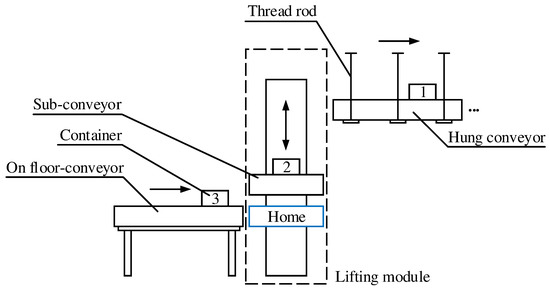
Figure 1.
The operation principle of the lifting module. The arrows indicate the travel direction of the container.
The line switching module redirects the conveyed containers to the switching point, as shown in Figure 2. The ball screw drive is used in this module to ensure a smooth horizontal movement.
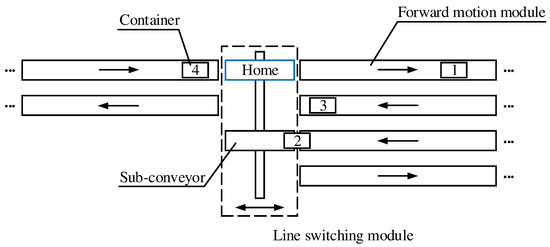
Figure 2.
The top-down view at the switching point.
The area of the Bach Khoa Research Center for Manufacturing Engineering (BK-RECME, Ho Chi Minh City University of Technology (HCMUT), Vietnam) is depicted in Figure 3 with three simulated stations. The element conveyors are designed with the standard length of 1 m, 2 m, and 4 m to determine a completed structure of the forward motion module. The forward motion modules will then be combined with other mechanical modules to design the absolute system.
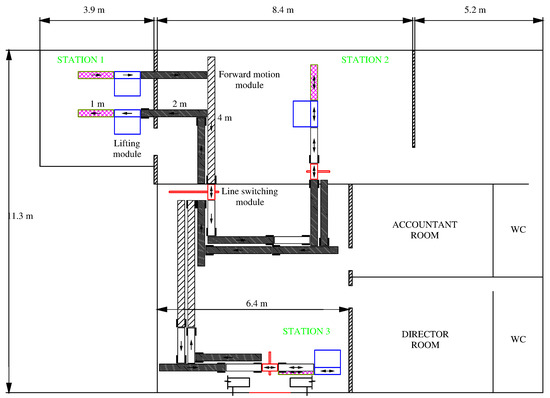
Figure 3.
The drawing of Bach Khoa Research Center for Manufacturing Engineering (BK-RECME).
For the control system, a user interface program is built to produce a server, to manage and control the container routes. The program is developed on a C++ platformQt Creator [10]. The database MySQL is chosen for the system. The data from the database will not be transmitted directly to the PLC, but the server. At that time, the server will process the data and send the messages to the PLC to enable the output port, as indicated in Figure 4.
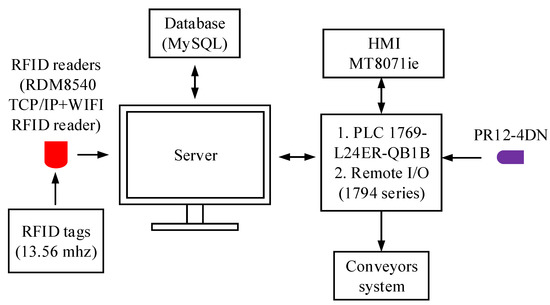
Figure 4.
The overall functional block diagram of the control system.
The RFID reader sends the containers’ name tag to the PC via TCP/IP. The type of RFID reader chosen is RDM8540-Q-A, the frequency is 13.56 MHz, and the available reading range is less than 8 cm. The selected reader supports both TCP/IP and Wi-Fi protocols. The PLC CompactLogix 5370 1769-L24ER-QB1B of Allen Bradley was also chosen for the system.
When scanning the RFID tag mounted on the container lid, the data from the RFID reader will be transmitted to the PC via TCP/IP for processing and deciding if the container is available to move or not. To limit the travel length of the mechanical modules, proximity sensors are used. To solve the problem at the switching point where multiple containers meet, proper control algorithms are necessary. The process will continue until the container reaches the station.
2.2. Mechanical Design
Figure 5 describes the mechanical principles of the plastic chain-conveyor, from which (1), (2), (3) are the electric motor, the chain drive, and the chain-conveyor, respectively. The design of a slat top chain-conveyor is selected based on [11]. The preliminary design parameters are the average speed: v = 0.4 (m/s); maximum workload: m = 7 (kg), including the weight of the product.
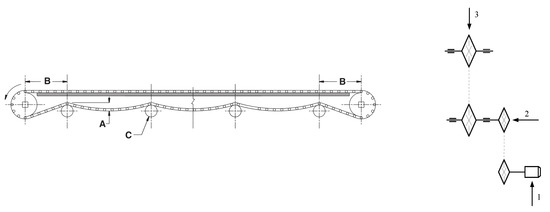
Figure 5.
The structure and principle diagram of the chain-conveyor [11], with A and B being the designed distance between the driven shaft and the roller C. Items (1), (2), and (3) are the driven motor, the chain transmission, and the chain-conveyor respectively.
In the lifting module, there are two separated mechanical components, which are the chain drive for upward and downward motions, and a sub-conveyor mounted on the actuator. The chain drive uses a counterweight on the opposing side of the actuator to balance and reduce the motor’s torque required, as illustrated in Figure 6 and Figure 7.

Figure 6.
The principle diagram of the lifting module.
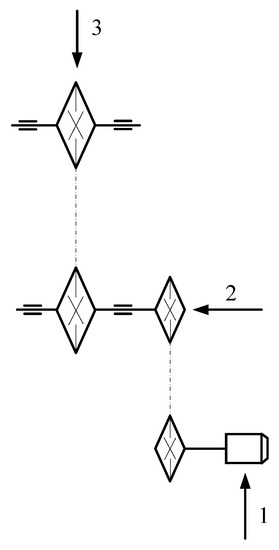
Figure 7.
The principle diagram of the lifting module.
The preliminary parameters are as follows: The distance between the two shafts is 3 m, the upward and downward speeds are the same value of 0.2 m/s. The total weight of the sliding actuator and the sub-conveyor is 20 kg. The maximum of the medicine container is 7 kg. The counterweight is calculated by the weight of the actuator plus 50% of the maximum load, because the system does not always lift the maximum load, but there are times when it runs freely. Hence, kg.
Figure 8 shows the mechanical diagram of the line switching module. The transport system utilizes two types of line switching modules: the 2-line and 4-line types, which operate similarly but have a different screw length, 0.6 m and 1.2 m, respectively. The 2-line switching module acts as a transfer unit between sending and receiving processes, while the 4-line switching module acts as a line-directing unit from one station to another. Therefore, it decides the exact route for medical containers to be transported.

Figure 8.
For horizontal movement of the line switching module, a ball screw drive is used and a sub-conveyor is mounted on the actuator.
As mentioned, the overhead conveyor system is designed to utilize the ceiling as its workspace. In Figure 9, the arrangement of the overhead system is represented. Threaded rods allow the conveyor support frame to be adjusted to calibrate the height between the conveyor surfaces.
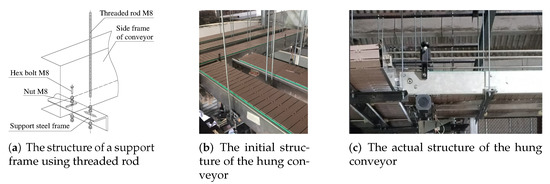
Figure 9.
An brief introduction of the hung conveyor system.
2.3. Method to Evaluate The System
For the assessment of the absolute system, technical tests for an comprehensive evaluation of the mechanical modules, along with specific experiments for the absolute system, will be carried out. These experiments are to evaluate these factors:
- (1)
- The stability and rigidity of the overhead system: During the testing operation conditions, vibrations, shaking, or displacements will be noted to regard how they affect the absolute system.
- (2)
- The control algorithm: The transport operation depends significantly on this factor, especially the control algorithm for the line switching module to transport the container to the desired stations. Therefore, simulation, as well as experiments, will be performed to check if the control algorithm is appropriate or if any logic error occurs.
- (3)
- The control model: As shown in Figure 4, the interaction between the server, the PLC, the access to the database, and the signal receiving unit (sensors and RFID readers) will also be evaluated through the experiments.
- (4)
- The performance of the system: For a comprehensive assessment that covers all situations of the system operation, the experimental transport process will be performed according to specific criteria stations and situations.
The purpose of these tests is to evaluate how the mechanical components, the control block, the management block, and the sensor block interact with each other, or if any issues expect improvement. The detailed experiments are presented in Section 3.3, along with the results.
3. Results
3.1. Overview of the Controlled Module Characteristics
3.1.1. The Characteristics of Forward Motion Module
As mentioned above, the forward motion conveyor module consists of many small sizes of forward motion conveyors to arrange a proper line. With multiple component conveyors, the module can certainly transport many containers at the same time. Two RFID readers are placed on both two ends of the modules to help identify a container entering or leaving the module, as shown in Figure 10. Moreover, these RFID readers can determine the number of containers on the module at any given time.

Figure 10.
The structure of a forward motion module with sensors.
To avoid the fact that the entire forward motion module, which includes multiple conveyors, is turned on at the same time, whether there are many containers or only one container, electrical counters and proximity sensors are used. With the detection of proximity sensors and counters, the number of containers on each conveyor is determined. Then, each conveyor is only activated when there is at least one container on the conveyor (counter value greater than 1). Otherwise, the conveyor will not be activated. This process is described in Figure 11 below.

Figure 11.
Sequential activation of the forward motion conveyor in the forward motion module.
3.1.2. The Characteristics of the Lifting Module and the Line Switching Module
The two modules (the lifting module—Figure 12 and the line switching module—Figure 13) are controlled in a sequential manner. The transportation sequence will be considered as follows:
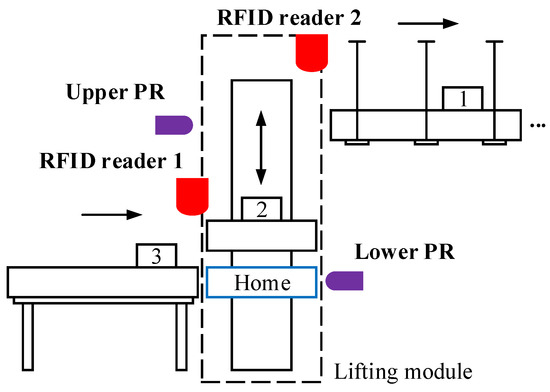
Figure 12.
The structure of the lifting module with sensors.
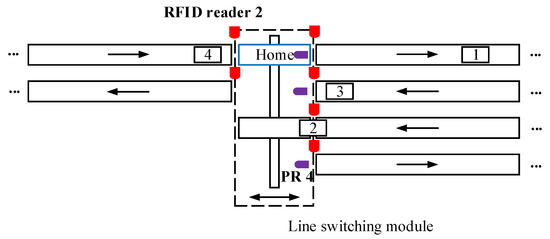
Figure 13.
The structure of the line switching module with sensors.
- (1)
- Sub-conveyor of the module has reached the right position.
- (2)
- Let the goods move into the lifting module or switch-line module.
- (3)
- Initiate the lifting or line switching operation.
- (4)
- Transport the goods into the next forward motion conveyor module.
The module can merely handle one container at a time. Therefore, if the module is handling one container, the previous modules must wait until the module completes the transport sequence. Conversely, if there is no container left to be transported (being lifted or switched), the module will stop. Two RFID readers are mounted on both two ends of the module to identify if a container is entering or leaving the module. In addition, the proximity sensors help to limit the movement of the conveyor module.
3.1.3. The Problems Related to the System’s Sensor
- (a)
- At least one RFID’s signal is lost during the system’s operation.
The RFID signal affects the control operation of the system, i.e., the processing of the server. As for the ATS system, when the signal from the RFID reader is lost, the system will stop (because the scan loop confirming the connection between the RFIDs is performed continuously). The data of the goods are name, location, path, etc. The data of the conveyor module comprise the states, number of consignments, etc. The data of RFID states are connection state, reading state. All three types of data mentioned above are stored in a database and are accessible through GUI. If the system is detached from the RFID signal, the user can navigate the location of the disconnected RFID signal. The detail of the storage of data in the database is mentioned in Section 3.2.1.
- (b)
- The proximity sensor’s signal is lost during the system’s operation.
The proximity sensor helps limit the conveyor’s travel distance. Therefore, whenever a sensor loses its signal, it will affect the operation of the conveyor module (the conveyor exceeds the travel distance), i.e., managing the operation of the PLC. To overcome this problem, additional sensors as limit switches are needed. To be specific, when the proximity sensor loses its signal, then the limit switch will cut off the power of the entire modules to limit further damage for the system, as described in Figure 14.

Figure 14.
Using an additional limit switch to limit the travel distance of the lifting module.
3.2. The Design of Electrical and Controller of the Entire System
3.2.1. The Overall Design of the Controller of the System
The transportation system is built with functional blocks as described in Figure 15:
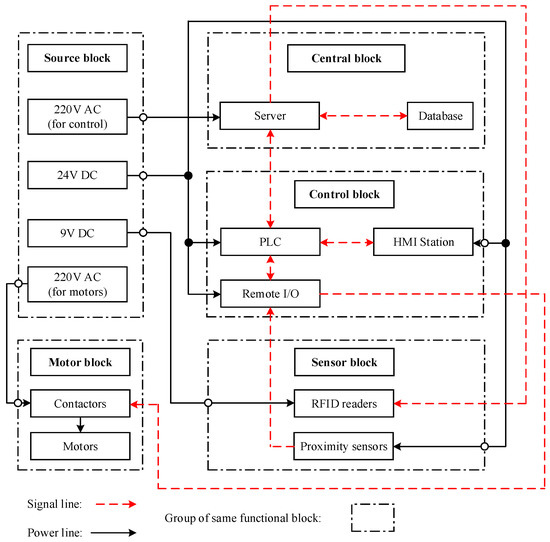
Figure 15.
The overall control block of the entire system.
- The role of the central block:
- –
- Server receives data of sensor block and operation of conveyor module from control block for further processing.
- –
- Send data after processing at the control block to operate the conveyor module.
- –
- Send data after processing to store in the database.
- –
- Database stores data of containers, conveyor modules and RFID sets. There will be no data lost in the event of a power failure or system shutdown.
- The role of the control block:
- –
- PLC receives data from the server then transmits it back to the remote I/O in order to operate conveyor modules corresponding to stations.
- –
- Acts as an intermediary to receive proximity sensor signals and send them back to the server.
- The role of the sensor block: Including RFID sets and proximity sensors to limit the travel distance of the conveyor and determine the number of containers on a module.
- The role of the motor block: The transmission system for the entire transport system.
- The role of the source block: The power supply for the entire transport system.
Preliminary operating process of the system:
- (1)
- GUI (graphical user interface): Built on the server, allowing to choose the transport route for a container, helping the user monitor and check for the operation of the transportation system (cargo, conveyor modules, etc.).
- (2)
- HMI: Placed at the stations for the users to set up the route of transport for the containers.
- (3)
- Conveyor module system: Helps transport containers according to the built-in control logic.
- (4)
- Server, PLC, sensor system, etc.: Help to control the operation of the system automatically.
3.2.2. Simulation of the Routing Algorithm
The simulation of the transportation system includes the following process:
- (a)
- Make a database connection and send the data back to the GUI.
In a real system, there may be a risk of system power failure. The requirement is that when the power is turned back on, the system will continue to work effectively. Therefore, during the runtime process, the system will constantly update the data, supporting the system to maintain operating properly in case of a reboot situation. The parameters will be updated in the database according to three tables: container (also called “box”), counters, and moving modules (Figure 16).
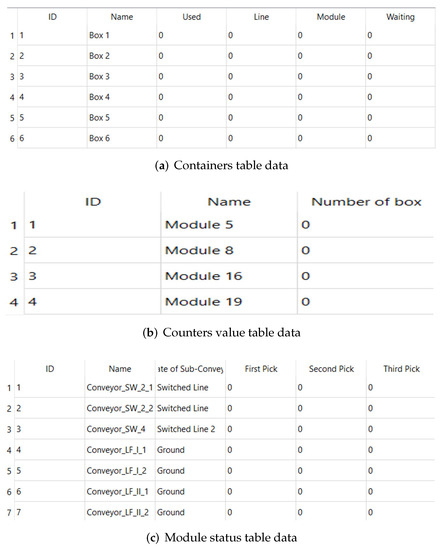
Figure 16.
Database information.
The updated parameters include the following:
- (1)
- Containers table (boxes table): The used, line, module, and waiting variables of each box to determine the location and state of each box.
- (2)
- Counters value table: Variable number_of_box bidirectional modules at stations.
- (3)
- The variable state_of_sub_convey will be updated to identify the location of the sub-conveyor of the lifting and line switching modules. Particularly, the 4-line switching module will update three more variables, first_pick, second_pick, and third_pick to determine the order of the box.
- (b)
- Handling of logic at the position of the lift conveyor module.
The lifting module represents a link between a ground-level conveyor system and a ceiling-mounted conveyor system. The problem to be overcome is when a container arrives and needs to be lifted but the sub-conveyor of the lifting module is already occupied. According to Figure 17, when container 2 reaches the waiting position for the lifting module, there is already container 1 present on the lifting module (module 18). At this time, the waiting variable of container 2 will be ON and the PLC will turn off the previous forward conveyor module. At that time, both containers 2 and 3 stop.
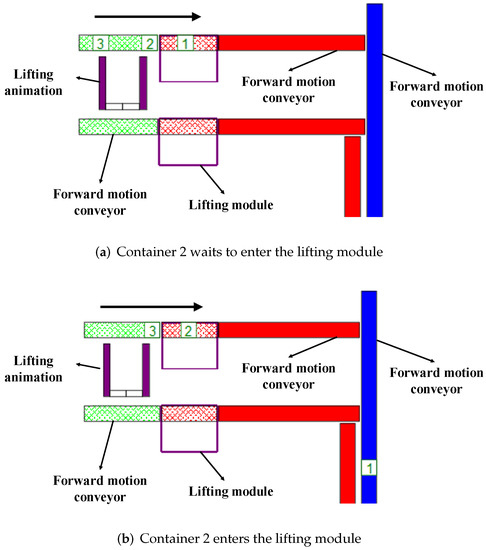
Figure 17.
Operation of the lifting module.
After container 1 is transferred to the next forward conveyor module (module 19) and the sub-conveyor of the lifting module has returned HOME, container 2 is transferred to the lifting module and container 3 will enter a waiting state. Therefore, the variable for the waiting status of container 3 will be turned ON.
- (c)
- Handling of logic at the position of the 2-line switching module.
A 2-line switching conveyor module is a module that moves the container in and out of the stations.
Situation 1: Containers only travel from the stations out.
The system lets the containers go out sequentially according to the priority order. It will be similar to the lifting module. After 1 container moves to the next module, the sub-conveyor of the line switching module will return HOME to pick up the next container. The process is described in Figure 18 below.
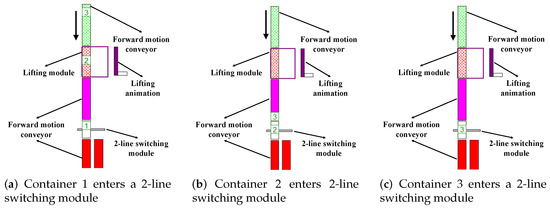
Figure 18.
Handling situation 1 at the 2-line switching module.
Situation 2: When there is a container that needs to go in, but there is additionally another container going out, and vice versa.
As shown in Figure 19, at the stations, there is a bidirectional forward motion conveyor module. There is only one direction activated at a time.
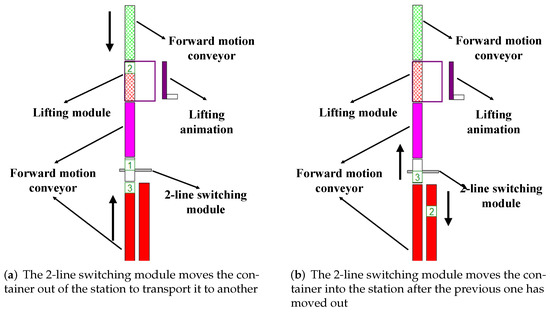
Figure 19.
Handling situation 2 at the 2-line switching module.
- (d)
- Handling of logic at the position of the 4-line switching module.
A 4-line switching module is the transfer unit at the meeting point of the lines, which helps move and separate containers.
The key issue is to prioritize the order of each container when there are several containers at the 4-line switching module (Figure 20). The solution is that the container that gets there first will go first. However, a distinctive feature is that the returning empty containers will have higher priority than those with the item inside.

Figure 20.
Handling situation 2 at the 4-line switching module.
3.3. Experimental Results
After researching and designing the mechanical system and the control algorithm, some assumptions and constraints were set to verify the ability to transport containers among the stations:
+ Some assumptions of the system:
- (1)
- The containers can move through the gap in transition between the two conveyors.
- (2)
- The different height between the surfaces of the conveyors is negligible and can be ignored.
- (3)
- No abnormal errors occurred in the control model (PLC can handle the operation of the mechanical modules properly, TCP/IP transmission standard can function effectively without error, system data is constantly updated to the server and stored in the database).
+ Some constraints of the system:
- (1)
- Safety factor (the ceilings of buildings must be sufficiently rigid—related to construction site inspection; the system must be examined for durability to select the appropriate material).
- (2)
- The overhead conveyor system after being installed on the truss must operate effectively, without shaking or jamming the container during transport.
- (3)
- The system needs to be expandable and easy to install. The input/output for the control module need to be reduced to a minimum.
- (4)
- Containers must stop at the exact position (entrance and end position of modules, middle of the sub-conveyor).
- (5)
- The containers must always be in the middle of the conveyor width along the length of the conveying stroke (to ensure that there are no jams or entanglements during the transition where the conveyors are perpendicular to each other).
From the assumptions and constraints of the system, we conducted several experiments to test the efficiency, precision, and accuracy of the whole transportation system. The experimental process is carried out by following these steps:
- (1)
- Building a control function for the lifting module, the line switching module and performing experiments to check the operation of each mechanical module separately before installation. The experimental test of each module helps us to observe the other mechanical features that do not meet the previous assumptions and constraints. This issue is explained in detail in the Discussion section.
After completing the installation:
- (2)
- Perform experimental transporting processes according to the designed algorithm to check the correctness of the proposed control model and the proposed control algorithm. This experiment confirms the feasibility of the research in designing an MSMC ATS to help transport containers from one station to others and vice versa.
3.3.1. The Experimental Test to Evaluate the Operation of Each Mechanical Module
As mentioned in Section 2.3, before installation, it is necessary to perform technical tests concerning the algorithm that we have built for each module.
As a result, the lifting and line switching modules function effectively according to the designed algorithm. Figure 21 and Figure 22 illustrate the mechanical module during the operation.
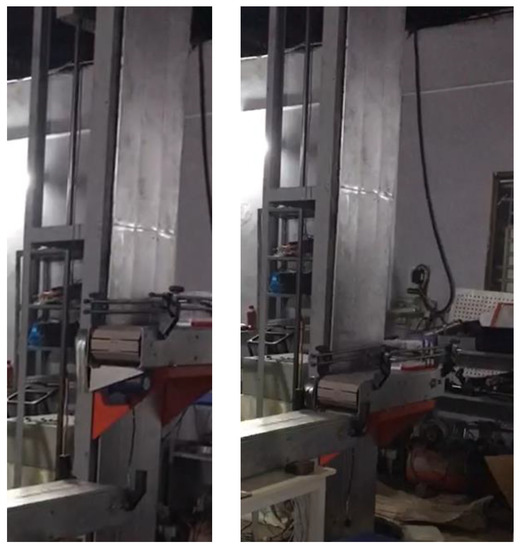
Figure 21.
The technical test for the lifting module.

Figure 22.
The technical tests for the line switching module.
3.3.2. The Experimental Tests to Evaluate the Operation of the Entire System
The whole system after installation at BK-RECME is shown in Figure 23.
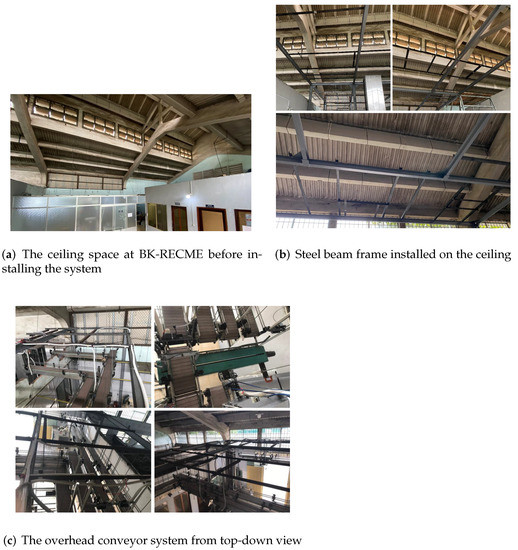
Figure 23.
The completed overhead conveyor system installed at BK-RECME according to the drawing in Figure 3.
For the experiments, a prototype system with three stations is tested. In addition, the control algorithm also ensures the transportation system of m containers (m > 3). In this practical setup, the whole system includes three containers.
With three stations, there are six corresponding routes. The containers are transported on separate routes to ensure the consistency of the algorithm in operation. The consistency manifests itself in two ways. First, the sub-conveyors of the lifting and line switching module are checked if they return to HOME position as mentioned above. Second, the line switching modules need to take the entry order into account, as explained in the simulation (occurs in all routes). As a result, the containers completed all six transport routes from station to station. The process of transporting containers according to a route from station 3 to station 1 (one out of six routes) is shown as in Figure 24.
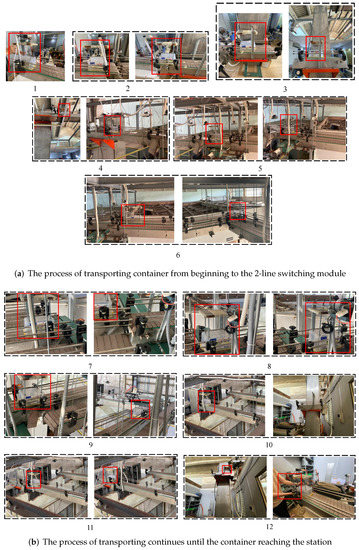
Figure 24.
The transporting procedure of the container according the route from station 3 to station 1.
According to Figure 24a, the transportation process is as follows: The user places the container at station 3, as shown in photo 1 in Figure 24, then the container will be transported into the lifting module as in photo 2. After that, the container will be lifted up as shown in photo 3. Next, the container exits the lifting module to enter the 2-line switching module as shown in photo 4 and photo 5. After the container exits the lifting module, the lifting module will return to HOME position. At that time, the container exits the 2-line switching module as shown in photo 6; when the container is completely out, the 2-line switching conveyor will return to HOME.
According to Figure 24b, the container will subsequently continue to go to the 4-line switching module and enter into the module, as shown in photo 7 and 8. The container will go to the corresponding line and then exits, as shown in photo 9. Next, the container will wait for the lifting module, as shown in photo 10. After that, the container will enter the lifting module to be lowered down to the lower limit, and the container will go to station 1 as shown in photo 11 and 12.
After that, the experimental transportation is performed many times with three containers according to optional chosen travel routes to check for logical errors in the algorithm. During transport, communication between PLC devices, the server, and the process of updating data into the database is monitored. After multiple operations, testing, and modifications, Figure 25 below introduces a common testing process of our system.


Figure 25.
The transporting procedure of the container according to optional routes.
According to Figure 25a, the process of transporting the containers according to optional chosen routes is as follows: The user places container 1 at station 3, as shown in photo 1 in Figure 25, then container 1 will move into the lifting module as shown in photo 2 and then be lifted to the upper limit, as shown in photo 3. Meanwhile, the user continues placing container 2 at station 3, then container 2 will go to the waiting position for entering the lifting module as shown in photo 4. Then, the lifting module travels to the upper limit and container 1 will go out of the lifting module to enter the 2-line switching module, as shown in photo 5 and photo 6. After container 1 is out of the lifting module, the lifting module will return to HOME to transport container 2. Next, container 1 will be switched to another line, and when it reaches the destination, container 1 will be out of the 2-line switching module as shown in photo 7 and photo 8. When the lifting module at station 3 returns to HOME, container 2 will be moved into the lifting module and lifted to the upper limit, as shown in photo 9 and photo 10.
According to Figure 25b, after being lifted to the upper limit, container 2 will go out of the lifting module and wait for the 2-line switching module returning to HOME, as shown in photo 11 and photo 12. At the same time, the user places container 3 at station 2, and it will move into the lifting module and then be lifted to the upper limit as shown in photo 13 and photo 14. After being lifted to the upper limit, container 3 will go out of the lifting module to move into 2-line switching as shown in photo 15 and photo 16. Next, container 3 will go out of the 2-line switching module as shown in photo 17. At container 2’s position, container 2 enters the 2-line switching module as shown in photo 18. When the destination has been reached, container 2 exits the line switching module. Simultaneously, container 1 arrives at the 4-line switching module’s position and it will wait for the sub-conveyor to arrive at the container pickup position; at the same time, container 2 will also stop because container 1 and container 2 are on the same conveyor line as photo 19 and photo 20.
According to Figure 25c, container 1 moves into the 4-line switching module and then goes out as shown in photo 21. At that time, it will go to the waiting position for entering the lifting module, then container 1 will move into the lifting module as shown in photo 22 and photo 23. After that, container 1 is lowered to the lower limit and goes to station 1 as shown in photo 24. At the 4-line switching module, container 3 comes before container 2. However, container 2 will enter the 4-line switching module first as it has a higher priority than container 3, as shown in photo 25. At that time, after reaching the destination, container 2 goes out of the 4-line switching module as shown in photo 26 and photo 27. Similar to container 1, container 2 will continue to go to the 2-line switching module then go out into the lifting module, as shown in photo 28, photo 29, and photo 30.
According to Figure 25d, container 2 is lowered to the lower limit and then goes to station 2, as shown in photo 31. Back to the position at the 4-line switching module, container 3 enters the module then goes to the corresponding line and exits the module as shown in photo 32, photo 33, photo 34, and photo 35. Next, container 3 will go to the position where the lifting module lifts it to the upper limit, then enter the module and go down to the lower limit and then go out to return to station 1, as shown in photo 36, photo 37, and photo 38. The transportation process of container 1, container 2, and container 3 is then complete.
3.3.3. Evaluation of the Experimental Results
The experimental transportation with three containers among three stations optionally has proved that the proposed algorithm can function efficiently. Simultaneously, the proposed control model ensures to manage the operation of the entire transportation system.
The experiments demonstrate that when the system is operating, vibration and noise occur. These problems will be addressed in the Discussions section.
The assumptions and constraints are satisfied after testing along with modifying. The details of the modification will also be addressed in the Discussion section.
4. Discussions
In Figure 3, the proposed control algorithm is applied in the real system to test the ability to transport containers according to the system built at BK-RECME. During the researching and designing process, the authors considered and solved several problems that resulted in the container being unable to complete the travel routes, such as (1) transition position between two conveyors (Figure 26); (2) perpendicular position between two conveyors (Figure 27); (3) placement of the proximity sensors on the sub-conveyors (Figure 28); (4) the location of the RFID readers to help identify containers entering or leaving the modules (Figure 29); (5) the system can be expanded, so it is necessary to ensure easy installation and a minimum number of inputs/outputs of the control modules. In other words, the system is helped to satisfy the assumptions and constraints set.
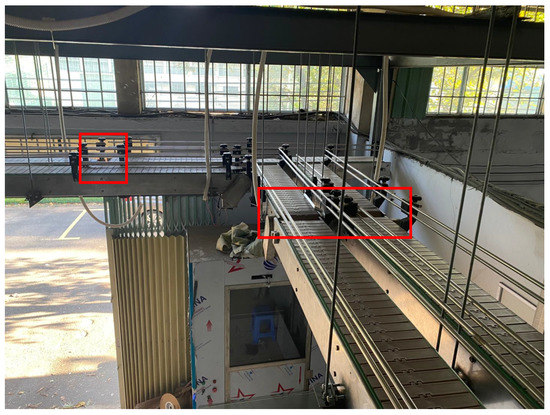
Figure 26.
Transition position between two conveyors.

Figure 27.
Perpendicular position between two conveyors.
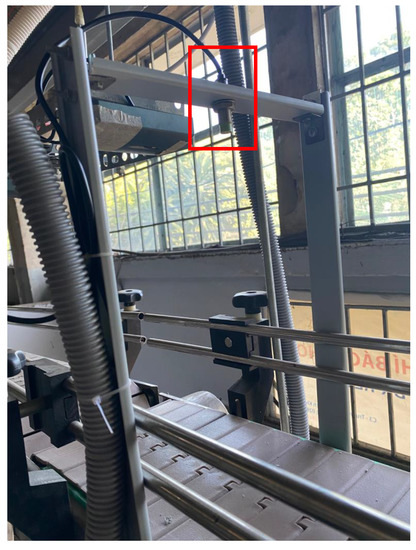
Figure 28.
The installation position of proximity sensors on the sub-conveyors.
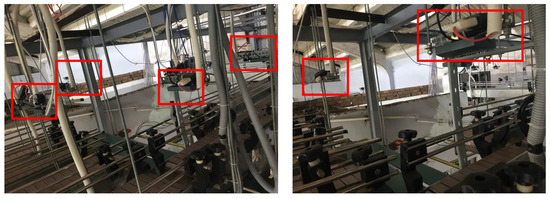
Figure 29.
The installation position of RFID readers to help identify containers entering or leaving the modules.
- For the problem (1), to address the gaps between the conveyors, segmented transfer plates could be used to help fill in the gaps so that the containers can pass through normally.
- For the problem (2), this is a featured design of the system; instead of using a curved conveyor, we arrange the conveyors perpendicular to each other, to save space and avoid cumbersome action, in designing the overhead system, as parallel curves will require different curvature radiation. To ensure the containers do not get stuck in transition at the 90-degree turn, additional guiding rails are used to help smooth and adjust the movement of the containers at those positions.
- For the problem (3), we design the frame to place the proximity sensor PR12—4DN [12] for ensuring that the containers will be detected when they pass through.
- For the problem (4), the selected RFID reader is RDM8540 TCP/IP + WIFI RFID reader series. It can recognize RFID tags within 8(cm) [13]. When the conveyor module is shut off, the container’s inertia may cause the container itself to fall off the conveyor. Therefore, RFID readers need to be placed at the appropriate position in each conveyor module. On the other hand, to ensure the containers are detected, we propose to use more than one RFID reader at each position and more than one RF-tag on each container.
- For the problem (5), the system is designed in modules to ensure interchangeability, replaceability, and ability to expand to a larger-scale system. Therefore, the control system would also need to follow the modular design. For each mechanical module, there will be a separate control function. The algorithm built in combination with the model, as in Figure 4, makes it easier to control the system. A special feature is that instead of using one output for each conveyor, which leads to an extremely large number of system outputs, we only use one output for the whole forward motion module, which consists of multiple component conveyors. Based on the built-in model in Figure 3, we decided to combine all the conveyors between the line switching modules and the lifting modules into one control module. The RFID readers will be used to limit the two ends of a module as in Figure 10 and minimize the output for the control module.
With the following experimental results from Section 3.3, (a) the lifting and line switching modules operate suitably according to the proposed algorithm; (b) the system can help to transport containers corresponding to selected routes, and the control model helps control and manage the data of the whole system. To further clarify this issue, we consider the following comments:
- As for the experiment (a), during the operation test, we also check the sensor position as mentioned in Section 3.1 to ensure that the conveyor operates in the exact limited range. As for the lifting module, it is also necessary to adjust the position of the limit switches to ensure that the vertical movement of the sub-conveyor does not exceed the boundaries, which will lead to a collision between the sliding actuator and the sprocket.
- In addition to the experiment (a), we also test the delay between power off and reversing the conveyor direction and how it would affect the operation of the conveyor. To extend the operating life of the motor and guarantee electrical safety, the function for reversing the motor is only active after the motor has been turned off. From that, the operation of the lifting module and the line switching module are all sequential, so we use the PLC’s sequential function charts (SFC) [14] programming to build the function.
- As for the experiment (b) in Section 3.3, we provide a series of figures regarding the experimental process of transporting with three containers corresponding to any three routes. It shows that the algorithm solved the problems, such as waiting when another container was already in position and the lifting module or switching module is unavailable. The algorithm takes the priority order at the 2-line and the 4-line switching modules into account, in which the containers that come first will be moved in first. The result shows that the proposed control algorithm is effective.
- As for the control model from the experiment (b) in Figure 4, the experiment also shows that the data will be updated to the database whenever a signal is detected. The signal from the proximity sensors is sent by the PLC to the server via TCP/IP protocol [15] for processing. The server, after synthesizing the data from the proximity sensor and PLC, will process and send it back to the PLC to execute the system’s operation. After that, the data continue to be updated to the database, and the cycle repeats over again.
- As emphasized above, the database only requires updates when there are changes in the data. Because the data synchronization speed is set by MySQL by default to 200 ms, the server would be delayed during data processing if updates are continuously required, as the system is not multi-threaded. Therefore, within 200 ms of transmitting data, the server cannot process the data.
- In addition, experiment (b) also helps us to check if the system could function as normal again after being turned off. Based on the recorded data on the database, whenever there is a system power shutdown and then turned back on again, the previous data stored in the database could be obtained. Therefore, the system could continue activating the corresponding mechanical modules, and then update new information to the database, such as the ID of containers and their respective routes, etc.
5. Conclusions and Future Developments
5.1. Conclusions
The ATS using overhead conveyors has proved its feasibility when applied to BK-RECME. In summary, this paper describes the design and the operating principle, as well as presents the achievements of the implementation of the proposed ATS.
The results obtained from this study have shown that this system is feasible and can solve the transport and distribution problems mentioned in this paper. The experimental results satisfied the assumptions and related constraints, which were analyzed in the Discussions section.
After having researched, assembled, and experimented with the system operation, with the examination on the performance of the control block, the management block, and database, we identified several shortcomings, which are as follows:
- (1)
- The system vibrates while operating: During system performance testing, vibration is generated because the conveyors are not linked together, but rather are independent mechanical components. As a result, the conveyors will slightly oscillate in a narrow range, creating vibrations in the whole system. This problem is combated by creating an interlink frame between the conveyors, helping to keep the absolute system in a unified and stable block.
- (2)
- The noise was generated because of the gearing between the sprocket and the chain of the plastic chain. These represent typical characteristics of the chain-conveyor during operation, and it will require some more innovations to overcome this phenomenon. As a result, this noise may cause discomfort to people in the operating environment, or is not sufficient to satisfy the criteria when applied to office buildings, hospitals, etc.
- (3)
- The data transmission line between devices (server, PLC, and database) could be upgraded: An increase in a number of stations in a system will lead to many more data and system variables. Hypothetically, the more variables that occur, the more complicated and difficult it becomes to communicate data through manual TCP/IP. Consequently, the system could be much trickier to control due to the senior level of complexity, although the cost when using TCP/IP protocol is completely reasonable. Fortunately, the prototype system in this paper consists of only three stations and could be applied with manual TCP/IP protocol with little problem.
- (4)
- The system has only experimented in a three-station prototype: As the system was implemented at Bach Khoa Research Center for Manufacturing Engineering (BK–RECME, Ho Chi Minh City University of Technology (HCMUT), Vietnam), it was built on a scale of three stations (according to the model in Figure 3). The next target is to expand the system on a larger scale with n stations (n > 3) to help transport m containers.
This system has been researched and designed to solve the problem of transporting goods utilizing the space above the ceiling, with the feature of automated line switching to coordinate products flexibly between stations. Although this system is not advanced when compared to other modern systems in the world, it has effectively solved the problem with a more feasible approach. With this system, the load capacity and productivity are far beyond that of the pneumatic system, and the flexibility is also higher than that of the AGV system. This ATS will also avoid space inadequacies when frequent people are passing by because many buildings are already designed and do not plan appropriate aisles for the AGV.
Another important innovation is the control algorithm of the system. The authors have come up with a control algorithm for routing and handling the situation if many containers are moving in opposite directions at the line switching point. The proposed algorithm is one of the key points determining the performance of the system. This algorithm has opened up many development directions for transport using multi-station systems, as the success of the line switching algorithm will set the foundation for expanding the system to more stations, more containers, and more lines.
Finally, the solution of using counters in combination with the conveyor has solved the problem of energy savings, especially when expanding the system to a larger scale with even more conveyors. This solution ensures that a conveyor will only be activated when the number of containers it carries is more than one, regardless of how many conveyors there are in the entire system.
In conclusion, this research has contributed a new solution for freight as well as logistics. A particularly important achievement of this research is the integration of the line switching feature along with the appropriate logic algorithm into the conveyor system, making the transportation process more flexible and space-saving, while still ensuring reasonable costs. The potential of this system is a commercial application in automatic transportation of a variety of products in many different environments, such as factories, office buildings, hospitals, etc. The potential solution is feasible. This proposed system is developed considering all the available conditions in Vietnam, with the key element being the control algorithm at the location of the line switching module to serve the process of moving containers between stations.
5.2. Future Developments
The mechanical structure of the absolute system has been fully designed and installed while ensuring efficient operation. In addition, an appropriate algorithm for addressing the distribution problem has been completely proposed; therefore, the system could operate with no significant logical error. The effective absolute system has been completely manufactured and installed; therefore, proper tests were carried out, ensuring the practical applicability of the system. With the shortcomings stated in Section 5.1, the following development of the system is proposed:
- As mentioned in Section 5.1, to solve problem (1) with the vibration, we have proposed a design of an interlink frame for the component conveyors. These interlink frames also need to be designed as a standardized module for easy installing and removal when access to component conveyors is required.
- For noise reduction (2), when considering the working environment that takes human factors into account, such as factories, warehouses, or hospitals, other alternatives for suitable types of conveyors could be implemented, such as PVC, roller conveyor, etc. On a side note, the team of authors also propose a future mechanical development, which is the development of aluminum casting technology. By casting an aluminum conveyor frame, the difficulties of tolerances and assembling could be reduced. It also helps the system run smoothly. This technique is already feasible and can also be applied in large-scale production to reduce costs.
- To solve problem (3) regarding data transmission, currently, the Open Platform Communications (OPC) standard is an effective tool for easier data communication. In the next steps, the OPC standard will be applied so that all data updates will be synchronized to the OPC server, making it easier to manage and control the system.
- Regarding issue (4), as mentioned, to expand the system, there are a few problems that needed to be considered:
- (a)
- The problem of management and quality control in mass production with generous quantities.
- (b)
- The appropriate plan for installation and maintenance of the overhead conveyor system, while still ensuring rigidity and conducting the deviation when the transport distance increases.
- (c)
- The problem of scaling the control algorithm, etc.
Author Contributions
These authors contributed equally to this work. The detail contribution of all the authors are listed as below: N.H.L.K.: Data curation; Methodology; Investigation; Software; Writing—original draft. V.A.P.: Conceptualization; Methodology; Validation; Writing—original draft. T.T.C.V.: Data curation; Conceptualization; Software; Validation; Visualization. V.T.B.D.: Resources; Visualization. T.D.T.: Resources; Software; Validation. N.P.N.: Methodology; Resources. T.Q.V.: Conceptualization; Funding acquisition; Methodology; Project administration; Supervision; Writing-review editing. All authors have read and agreed to the published version of the manuscript.
Funding
This research is funded by the Ho Chi Minh City Department of Science and Technology (DOST) under contract number 99/2019/HĐ-QPTKHCN.
Institutional Review Board Statement
Not applicable.
Informed Consent Statement
Not applicable.
Data Availability Statement
This study do not report any data.
Acknowledgments
The authors would like to express special thanks to the Ho Chi Minh City Department of Science and Technology (DOST) under contract number 99/2019/HĐ-QPTKHCN and the Bach Khoa Research Center for Manufacturing—Ho Chi Minh City University of Technology—Vietnam National University-Ho Chi Minh City, VNU-HCM, Vietnam.
Conflicts of Interest
The authors declare that there are no conflict of interests.
Abbreviations
The following abbreviations are used in this manuscript:
| ATS | Automatic transportation system |
| MSMC | Multi-station multi-container |
| PTS | Pneumatic tube system |
| PLC | Programmable logic controller |
| OPC | Open Platform Communications |
| PR | Proximity sensor |
| LS | Limit switch |
References
- Bolliger, D.; Seeberger, M.D.; Tanaka, K.A.; Dell-Kuster, S.; Gregor, M.; Zenklusen, U.; Grapow, M.; Tsakiris, D.A.; Filipovic, M. Pre-analytical effects of pneumatic tube transport on impedance platelet aggregometry. Platelets 2009, 7, 458–465. [Google Scholar] [CrossRef] [PubMed]
- Shibani, W.M.; Zulkafli, M.F.; Basuno, P. Methods of Transport Technologies: A Review On Using Tube/Tunnel Systems. In IOP Conference Series: Materials Science and Engineering; IOP Publishing: Bristol, UK, 1998. [Google Scholar]
- Halbig, H.; Gstöttmayer, W. Rail-Type Conveyor System; Telelift GmbH: Puchheim, Germany, 1998. [Google Scholar]
- Görner, M.; Benedikt, F.; Grimmel, F.; Hulin, T. SwarmRail: A Novel Overhead Robot System for Indoor Transport and Mobile Manipulation. In Proceedings of the 2020 IEEE International Conference on Robotics and Automation (ICRA), Paris, France, 31 May–31 August 2020. [Google Scholar]
- Van, V.H. Solutions for Human Resource Development of Mechanical Enterprises in Vietnam. In Proceedings of the 9th International Conference on Socio-Economic and Environmental Issues in Development, NEU-KKU, New York, NY, USA, 10 June 2018. [Google Scholar]
- Pane, S.F.; Awangga, R.M.; Azhari, B.R.; Tartila, G.R. RFID-based conveyor belt for improve warehouse operations. Telkomnika 2019, 17, 794–800. [Google Scholar] [CrossRef][Green Version]
- Vlad, V.; Graur, A.; Turcu, C.E.; Popa, C. Enhancing the Flexibility of Manufacturing Systems Using the RFID Technology. In Proceedings of the 2009 International Conference on Advanced Information Networking and Applications Workshops, Bradford, UK, 26–29 May 2009; pp. 630–635. [Google Scholar]
- Osman, M.S.; Ragman, A.A.A.; Mohamad, N.R.; Noridan, N.Z. Implementation of RFID on Reconfigurable Conveyor System. Proc. Innov. Res. Ind. Dialogue 2017, 16, 119–120. [Google Scholar]
- Quang, H.L.; Knyazev, N.S.; Knyazev, S.T. RFID systems and their development. In Proceedings of the 2018 XIV International Scientific-Technical Conference on Actual Problems of Electronics Instrument Engineering (APEIE), Novosibirsk, Russia, 2–6 October 2018. [Google Scholar]
- Qt Documentation. Available online: https://doc.qt.io/qt-5/index.html (accessed on 29 September 2021).
- Intralox. Product, design and installation guidelines. In Plastic Chains; Intralox: New Orleans, LO, USA, 2016. [Google Scholar]
- PR Series—Cylindrical Type Proximity Sensor. Autonics. Available online: https://www.instrumart.com/assets/Autonics_PR_Series_Proximity_Sensors_datasheet.pdf (accessed on 29 September 2021).
- RDM8540 TCP/IP+WIFI RFID Reader. RDM. Available online: http://www.datarfid.com/product/showproduct.php?id=19 (accessed on 29 September 2021).
- Logix 5000 Controllers Sequential Function Charts. Allen Bradley. Available online: https://literature.rockwellautomation.com/idc/groups/literature/documents/pm/1756-pm006_-en-p.pdf (accessed on 29 September 2021).
- TCP/IP Socket Interface. Allen-Bradley. Available online: https://literature.rockwellautomation.com/idc/groups/literature/documents/at/enet-at002_-en-p.pdf (accessed on 29 September 2021).
Publisher’s Note: MDPI stays neutral with regard to jurisdictional claims in published maps and institutional affiliations. |
© 2022 by the authors. Licensee MDPI, Basel, Switzerland. This article is an open access article distributed under the terms and conditions of the Creative Commons Attribution (CC BY) license (https://creativecommons.org/licenses/by/4.0/).